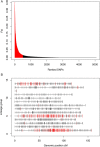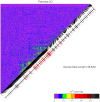Human-induced evolution caught in action: SNP-array reveals rapid amphi-atlantic spread of pesticide resistance in the salmon ecotoparasite Lepeophtheirus salmonis
- PMID: 25344698
- PMCID: PMC4223847
- DOI: 10.1186/1471-2164-15-937
Human-induced evolution caught in action: SNP-array reveals rapid amphi-atlantic spread of pesticide resistance in the salmon ecotoparasite Lepeophtheirus salmonis
Abstract
Background: The salmon louse, Lepeophtheirus salmonis, is an ectoparasite of salmonids that causes huge economic losses in salmon farming, and has also been causatively linked with declines of wild salmonid populations. Lice control on farms is reliant upon a few groups of pesticides that have all shown time-limited efficiency due to resistance development. However, to date, this example of human-induced evolution is poorly documented at the population level due to the lack of molecular tools. As such, important evolutionary and management questions, linked to the development and dispersal of pesticide resistance in this parasite, remain unanswered. Here, we introduce the first Single Nucleotide Polymorphism (SNP) array for the salmon louse, which includes 6000 markers, and present a population genomic scan using this array on 576 lice from twelve farms distributed across the North Atlantic.
Results: Our results support the hypothesis of a single panmictic population of lice in the Atlantic, and importantly, revealed very strong selective sweeps on linkage groups 1 and 5. These sweeps included candidate genes potentially connected to pesticide resistance. After genotyping a further 576 lice from 12 full sibling families, a genome-wide association analysis established a highly significant association between the major sweep on linkage group 5 and resistance to emamectin benzoate, the most widely used pesticide in salmonid aquaculture for more than a decade.
Conclusions: The analysis of conserved haplotypes across samples from the Atlantic strongly suggests that emamectin benzoate resistance developed at a single source, and rapidly spread across the Atlantic within the period 1999 when the chemical was first introduced, to 2010 when samples for the present study were obtained. These results provide unique insights into the development and spread of pesticide resistance in the marine environment, and identify a small genomic region strongly linked to emamectin benzoate resistance. Finally, these results have highly significant implications for the way pesticide resistance is considered and managed within the aquaculture industry.
Figures







Similar articles
-
A 200K SNP chip reveals a novel Pacific salmon louse genotype linked to differential efficacy of emamectin benzoate.Mar Genomics. 2018 Jul;40:45-57. doi: 10.1016/j.margen.2018.03.005. Epub 2018 Apr 16. Mar Genomics. 2018. PMID: 29673959
-
QTL mapping provides new insights into emamectin benzoate resistance in salmon lice, Lepeophtheirus salmonis.BMC Genomics. 2024 Dec 18;25(1):1212. doi: 10.1186/s12864-024-11096-2. BMC Genomics. 2024. PMID: 39695954 Free PMC article.
-
The mechanism (Phe362Tyr mutation) behind resistance in Lepeophtheirus salmonis pre-dates organophosphate use in salmon farming.Sci Rep. 2017 Sep 27;7(1):12349. doi: 10.1038/s41598-017-12384-6. Sci Rep. 2017. PMID: 28955050 Free PMC article.
-
Analysis and management of resistance to chemotherapeutants in salmon lice, Lepeophtheirus salmonis (Copepoda: Caligidae).Pest Manag Sci. 2002 Jun;58(6):528-36. doi: 10.1002/ps.482. Pest Manag Sci. 2002. PMID: 12138619 Review.
-
How sea lice from salmon farms may cause wild salmonid declines in Europe and North America and be a threat to fishes elsewhere.Proc Biol Sci. 2009 Oct 7;276(1672):3385-94. doi: 10.1098/rspb.2009.0771. Epub 2009 Jul 8. Proc Biol Sci. 2009. PMID: 19586950 Free PMC article. Review.
Cited by
-
A Survey of the ATP-Binding Cassette (ABC) Gene Superfamily in the Salmon Louse (Lepeophtheirus salmonis).PLoS One. 2015 Sep 29;10(9):e0137394. doi: 10.1371/journal.pone.0137394. eCollection 2015. PLoS One. 2015. PMID: 26418738 Free PMC article.
-
The potential for cleaner fish-driven evolution in the salmon louse Lepeophtheirus salmonis: Genetic or environmental control of pigmentation?Ecol Evol. 2021 May 16;11(12):7865-7878. doi: 10.1002/ece3.7618. eCollection 2021 Jun. Ecol Evol. 2021. PMID: 34188857 Free PMC article.
-
Genetic analysis redraws the management boundaries for the European sprat.Evol Appl. 2020 Mar 17;13(8):1906-1922. doi: 10.1111/eva.12942. eCollection 2020 Sep. Evol Appl. 2020. PMID: 32908594 Free PMC article.
-
Genome-wide survey of cytochrome P450 genes in the salmon louse Lepeophtheirus salmonis (Krøyer, 1837).Parasit Vectors. 2019 Nov 27;12(1):563. doi: 10.1186/s13071-019-3808-x. Parasit Vectors. 2019. PMID: 31775848 Free PMC article.
-
Not that clean: Aquaculture-mediated translocation of cleaner fish has led to hybridization on the northern edge of the species' range.Evol Appl. 2021 Mar 29;14(6):1572-1587. doi: 10.1111/eva.13220. eCollection 2021 Jun. Evol Appl. 2021. PMID: 34178105 Free PMC article.
References
-
- Bjørn PA, Finstad B. The development of salmon lice (Lepeophtheirus salmonis) on artificially infected post smolts of sea trout (Salmo trutta) Can J Zool. 1998;76:970–977. doi: 10.1139/cjz-76-5-970. - DOI
Publication types
MeSH terms
Substances
LinkOut - more resources
Full Text Sources
Other Literature Sources
Research Materials

